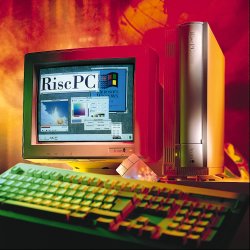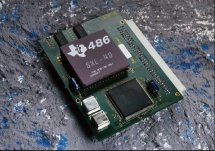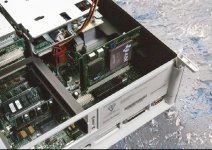Acorn Risc PC Second Processor Cards
What's a Risc PC?
The Risc PC is a computer produced in the United Kingdom by Acorn Computers. It is a development
of Acorn's Archimedes range of computers, which were the first personal
computers ever to use RISC processors.
 The Risc PC features lightning-fast manipulation of still and moving
graphics (the 64-bit graphics system supports 32-bit colour and resolutions up to 1600 x 1200),
high-quality 16-bit sound system as standard, up to 256MB of
RAM, a unique scaleable and expandable case design, and a low-cost processor upgrade path allowing all systems built since 1994 to be upgraded to the latest 233MHz StrongARM processor cards.
The Risc PC features lightning-fast manipulation of still and moving
graphics (the 64-bit graphics system supports 32-bit colour and resolutions up to 1600 x 1200),
high-quality 16-bit sound system as standard, up to 256MB of
RAM, a unique scaleable and expandable case design, and a low-cost processor upgrade path allowing all systems built since 1994 to be upgraded to the latest 233MHz StrongARM processor cards.
It is also one of the most
effective multi-processor multi-platform computer systems available, with
multi-processor options ranging from very low cost 486 second processor
cards
to high-performance 586 cards, and even multiprocessor boards allowing
up to six processors to be used simultaneously.
All Acorn's desktop computers, including the Risc PC, run Acorn's fully
32-bit RISC OS multitasking operating system, a compact, robust, easy to
use, and highly efficient
ROM-based multimedia operating system which has now been adapted by Acorn Network Computing for use in
Oracle's
network
computers. Acorn's own Netstation network computer, based upon the ARM7500FE chip, can be supplied for as little as US$300, and tens of thousands of
these systems have been built. Acorn have also produced a StrongARM-based network computer offering impressive Java performance; the StrongARM massively outstrips other processors in Java benchmarks.
All desktop RISC OS systems feature compatibility with other
platforms at various levels, including access to a wide variety of disk
formats, and both software and hardware emulation of IBM-compatible
systems. Portable
RISC OS systems are also available, soon to include the "peanut"
portable, made by
Interconnex UK.
Thousands of software titles are available for RISC OS, covering a wide
range of applications from multimedia to desktop publishing, and
including market-leading products like the powerful Eidos
Optima non-linear video-editing suite and the revolutionary Sibelius
music-processing system.
RISC OS systems use RISC processors developed by ARM Ltd., originally an
offshoot of Acorn itself, and now, in conjunction with Digital Semiconductor
(DEC) selling the much faster
StrongARM
processor range. ARM
processors provide very high performance combined with low cost, small size,
and low power consumption, and have already been used in the 3DO multiplayer game
system,
the Apple
Newton, Millipede's Apex
Imager video processing board, most of the network computers now being
developed, and numerous
other products ranging from high-end chess computers to GPS devices; the Psion 5 uses an ARM processor, as will future more powerful EPOC-32 based machines. Microsoft have also ported their Windows CE operating system to the ARM architecture in preference to the Intel processors they have traditionally used.
What's a PC Second Processor Card?
 The x86 second processor technology in the Risc PC was jointly developed by
Aleph One, Future
Technology Devices International and Acorn. Aleph One
had been responsible for 386 and 486 cards available for earlier RISC OS
systems, while Acorn had supplied low-cost DOS emulation software.
The x86 second processor technology in the Risc PC was jointly developed by
Aleph One, Future
Technology Devices International and Acorn. Aleph One
had been responsible for 386 and 486 cards available for earlier RISC OS
systems, while Acorn had supplied low-cost DOS emulation software.
x86 cards in the Risc PC differ from the earlier models
primarily in that they have direct access to the system's main memory
bus. This means that it is unnecessary to add additional RAM to the
processor card (which then cannot be used by the rest of the system) in
order to achieve decent performance. The PC card can utilise all the
existing hardware installed in the Risc PC system, including hard and
floppy disks, printers, modems, CD-ROM drives, scanners, and so on.
With a PC card in a RISC OS system, DOS, Windows or Windows 95 software
can be run either multi-tasking within a RISC OS window, or
single-tasking (taking up the whole screen); and it is possible to
switch between the two. When the PC card is being used in single-tasking
mode, the computer's ARM processor is used as a graphics accelerator for
the PC card, giving highly impressive graphics performance under Windows
or Windows 95.
A wide range of different PC second processor cards have been produced by
Aleph One, Acorn, and more recently CJE Micro's Acorn Centre of
Technology. Risc PC second processor cards give Risc PC owners the
ability to
run a whole range of software from different platforms seamlessly on the
same machine, sharing the same resources, giving performance equivalent
to dedicated IBM-compatible systems at a very reasonable cost.
How does it all work in practice?
 The PC card is a small circuit board, similar to the ARM processor card
fitted to every machine, which plugs into the empty processor
slot in any Risc PC. The PC card must go in the processor slot towards
the back of the machine, so that the processor faces away from the
ARM processor. Installation is simple; the top of the computer's case is
opened using the tabs at the back, and the PC card is inserted into the
appropriate processor slot, moving the ARM processor first if necessary.
You don't even need a screwdriver!
The PC card is a small circuit board, similar to the ARM processor card
fitted to every machine, which plugs into the empty processor
slot in any Risc PC. The PC card must go in the processor slot towards
the back of the machine, so that the processor faces away from the
ARM processor. Installation is simple; the top of the computer's case is
opened using the tabs at the back, and the PC card is inserted into the
appropriate processor slot, moving the ARM processor first if necessary.
You don't even need a screwdriver!
The RISC OS software required to run the PC card, (!PCx86,
!PC, or the latest version PC Pro), and
configure its operation (!PCconfig),
comes on an Acorn format floppy disk. !PCconfig is used to create a hard
disk partition (at least a hundred megabytes is recommended if you intend
to run Windows software) for use with the PC card. Two partitions can be
created with the standard software, or up to four if an additional
software utility is used. !PCconfig can also be used to set a number of
other options, such as whether the PC card starts up single-tasking
(full screen) or multi-tasking (in a RISC OS window).
You will need to install either Windows 95 or some other form of DOS in the PC partition; all the
PC cards supplied by Acorn or CJE come with IBM PC-DOS 7. This installation, and also the Windows and Windows 95 installation processes, is carried out
exactly following the manuals supplied with the software, just as if the
machine were a proper PC. For the best performance in Windows and Windows
95, be sure to install the latest version of the screen driver
ARMDRV.DRV, which allows the PC card to use the ARM processor of the Risc
PC as a Windows accelerator when in single-tasking mode.
On the old mk.1 Acorn 486SX PC cards, PC speaker sound (i.e. the simple beeping
noises that a PC without a sound card makes) can be obtained by using a
suitable cable (apparently available from Aleph One for 5ukp + VAT) to connect the sound connector on the PC card to a link on the Risc PC motherboard.
It appears that this connection does not allow the sound to come through
the Risc PC headphone jack, but only through the internal speaker. Some
people have also experimented with connecting a separate small loudspeaker (for
example, one from a BBC) to the link.
To obtain proper sound from the PC card, a 16-bit sound system is
required. This is included as standard with all Risc PC700 systems and more
recent Risc PC600 systems; owners of older Risc PC600 machines can
upgrade their machine with one of the sound card upgrades available, such
as the Minnie card from Expressive Software
Productions
(ESP), or the Mozart card from
Yellowstone Electronic Solutions.
Once your computer has these 16-bit sound facilities, the PC card software
includes soundblaster emulation, which allows speech, music and sound
effects to work on a number of PC games and applications (see the compatibility lists for details). Some games and applications also require MIDI support;
in order to implement this, you will require additional software, which
costs around 40ukp.
If you wish to allow an x86 card to access PC ethernet networks you will
also need the Network Links software. This is available from Aleph One, and is charged for on a
sliding scale according to the number of users.
Its solution is so much cheaper and more elegant than those on other non-PC
platforms.
- Acorn User, March 1995
I'd even challenge a regular PC user to be able to tell if they were using a real PC or not.
- Personal Computer World, June 1995
Very highly recommended.
- Micromart
User comments on the original 33MHz 486SX PC card
BTW, have you seen those DOS on PowerMac cards (486DX2/66). I installed one
in a 40MB PowerMac 7100. I allocate 16MB to that card. All I get is 8MB and
a very sluggish performance with Win95. And it even uses its own S3 graphics
card...
The Acorn TI486SXL 33MHz in my RiscPC is a two second plug-and-play card.
I have Win95 on that too, with 12MB ram allocated, emulating that
dreaded SVGA display and even then running six times faster than the
PowerMac above...
Macs are for fools who can't use computers and are therefore restrictive for
my way of working, thinking and creating things on a computer.
Rogier Carper
[email protected]
Polytechnic Hogeschool Enschede, The Netherlands
(used with permission)
PC Card Windows Speed
Date: Sat, 29 Apr 95 16:58:02 PDT
[email protected] writes:
In message [email protected] Frank Lyonnet wrote:
In the last SVM french mag (the best selling computer mag in france),
there is an article about the RPC PC card. The article is
very positive. Their Window bench give them a speed index comparable
to a DX2/66 with VESA local bus ... (truly !).
How did they manage that? I know the Windows screen driver speeds things up
for Windows, but I wouldn't expect it to do so that much.
Still, Acorn can't be sued for reviewers exaggerating the claims of their products, can they? :-) 8 out of 10 PC owners probably wouldn't know the
difference.
I am using the RISC PC card and I can quite happily say that the combined
PC card and RISC video driver makes it noticeably faster than the 486DX80 that
I run in the office.
The video display is VERY fast.
So far it has run every windows application that I have thrown at it.
This message was posted using Chameleon for Windows. The Risc PC is
quite happily running a PPP 28k8 link, web reader, mail reader, news reader
and in the background is performing a 1.2Mb ftp transfer. I might also add
that I also have Impression, Artworks, Vector and Edit running!!!
This is one smart computer.
Tony
[email protected]
(used with permission)
Back to RPC x86 Info Pages
Other interesting websites
 The Risc PC features lightning-fast manipulation of still and moving
graphics (the 64-bit graphics system supports 32-bit colour and resolutions up to 1600 x 1200),
high-quality 16-bit sound system as standard, up to 256MB of
RAM, a unique scaleable and expandable case design, and a low-cost processor upgrade path allowing all systems built since 1994 to be upgraded to the latest 233MHz StrongARM processor cards.
The Risc PC features lightning-fast manipulation of still and moving
graphics (the 64-bit graphics system supports 32-bit colour and resolutions up to 1600 x 1200),
high-quality 16-bit sound system as standard, up to 256MB of
RAM, a unique scaleable and expandable case design, and a low-cost processor upgrade path allowing all systems built since 1994 to be upgraded to the latest 233MHz StrongARM processor cards. The x86 second processor technology in the Risc PC was jointly developed by
Aleph One, Future
Technology Devices International and Acorn. Aleph One
had been responsible for 386 and 486 cards available for earlier RISC OS
systems, while Acorn had supplied low-cost DOS emulation software.
The x86 second processor technology in the Risc PC was jointly developed by
Aleph One, Future
Technology Devices International and Acorn. Aleph One
had been responsible for 386 and 486 cards available for earlier RISC OS
systems, while Acorn had supplied low-cost DOS emulation software. The PC card is a small circuit board, similar to the ARM processor card
fitted to every machine, which plugs into the empty processor
slot in any Risc PC. The PC card must go in the processor slot towards
the back of the machine, so that the processor faces away from the
ARM processor. Installation is simple; the top of the computer's case is
opened using the tabs at the back, and the PC card is inserted into the
appropriate processor slot, moving the ARM processor first if necessary.
You don't even need a screwdriver!
The PC card is a small circuit board, similar to the ARM processor card
fitted to every machine, which plugs into the empty processor
slot in any Risc PC. The PC card must go in the processor slot towards
the back of the machine, so that the processor faces away from the
ARM processor. Installation is simple; the top of the computer's case is
opened using the tabs at the back, and the PC card is inserted into the
appropriate processor slot, moving the ARM processor first if necessary.
You don't even need a screwdriver!